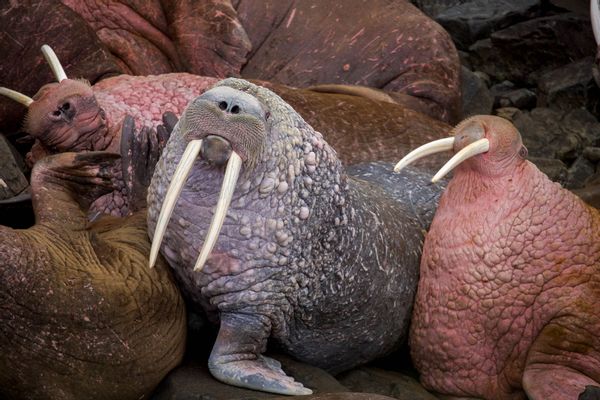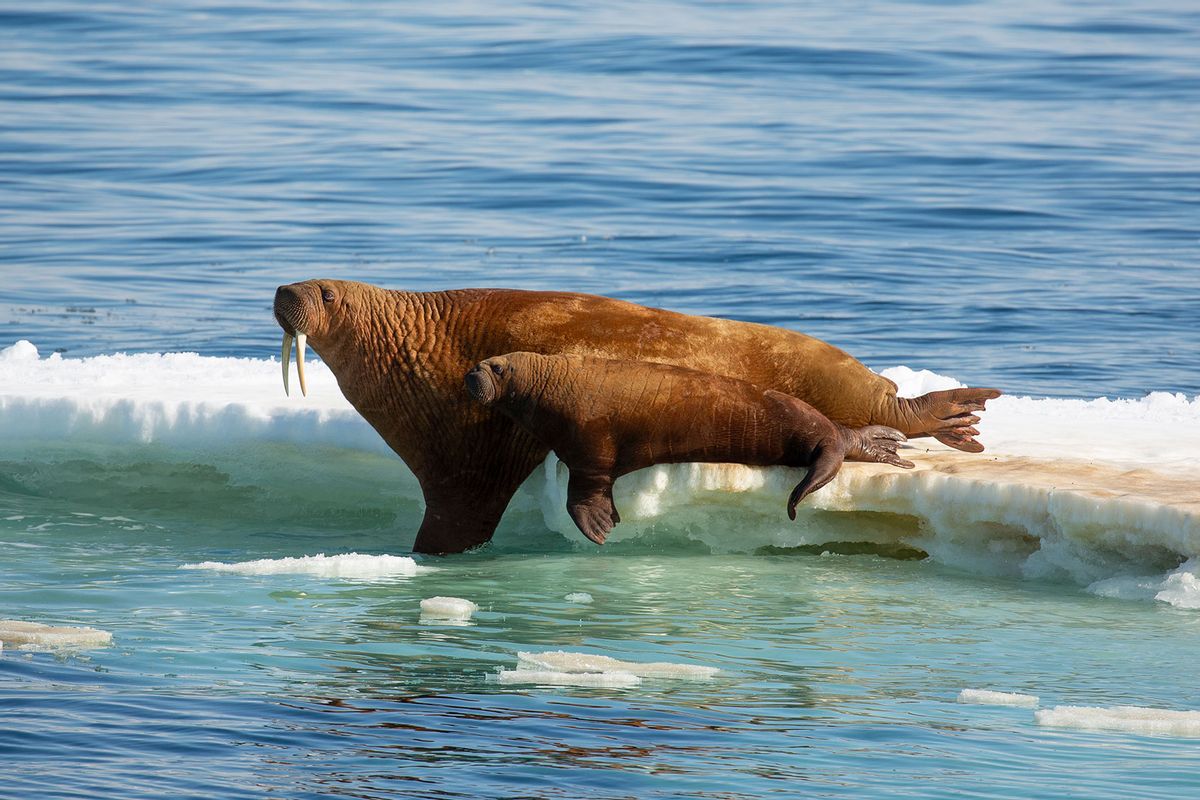Melting sea ice due to climate change isn’t just a problem for people living in coastal regions that are slowly being flooded. It threatens the survival of species like walruses, which are uniquely dependent on the disappearing frozen environment. As we burn fossil fuels, trapping heat that melts polar ice, the roly poly pinnipeds struggle to find sea ice to live upon. Additionally as the ocean becomes more acidic because of human activity, it makes it difficult for walrus prey like crabs, clams and sea snails to build their shells.
Wildlife biologist Dr. Devin Johnson of the Fish and Wildlife Service (FWS) Marine Mammals Management Walrus Program isn’t entirely pessimistic regarding the plight of these animals. He has fond recollections of interacting with the Atlantic (Odobenus rosmarus rosmarus) and Pacific (Odobenus rosmarus divergens) walruses that inhabit the area.
“It is always special to see these animals in their natural habitat, and stresses the importance of sea ice, particularly for mothers with young calves,” Johnson told Salon.
Since 2023, the FWS and U.S. Geological Survey (USGS) have both operated research stations in the Chukchi Sea, a region of the Arctic Ocean between Alaska and Siberia, with one of the scientists’ goals being to protect walruses. And to get help, they’ve enlisted the assistance of the internet.
Since 2021, more than 37,000 citizen scientists have participated in the Walrus From Space project, a joint project by the World Wildlife Fund (WWF) and British Antarctic Survey (BAS) for monitoring walrus populations. Ordinary citizens can sign up to examine six years worth of satellite imagery so they can count walruses. A recent story in High North News drew attention to the ongoing success of the program, reporting that volunteers have so far reviewed two years of a total six years of satellite images.
"Pacific walruses are specifically adapted for life in and around sea ice."
These programs are essential because climate change is one of the biggest threats to the ongoing survival of walruses, experts like Johnson agree. He added that there are many ways ordinary people can help walruses in addition to working to reduce global carbon emissions.
“There are some on-the-ground conservation measures that may help alleviate the stressors of climate change on the Pacific walrus population,” Johnson said. “For example, the Alaska Native village of Point Lay has taken an active role in the protection of a large walrus haulout that occurs seasonally near the village – working with the FWS to reduce disturbance-related mortalities.”
 Pacific walruses are harvested in Russia and Alaska. (Devin Johnson)
Pacific walruses are harvested in Russia and Alaska. (Devin Johnson)
He also pointed out that humans who rely on walruses for food still have ecologically positive relationships with the species. The Alaska and Chukotka Native communities have harvested walruses for millennia without endangering their population.
“A recent study indicates that current harvest levels are within a sustainable range and can continue into the future despite stressors associated with climate change,” Johnson said.
These efforts are going to be increasingly important as walruses struggle with the challenges posed by climate change.
Want more health and science stories in your inbox? Subscribe to Salon's weekly newsletter Lab Notes.
“Pacific walruses are specifically adapted for life in and around sea ice,” Johnson said. “Walruses (particularly females and calves) use broken sea ice habitat for much of the year as a platform to rest on between foraging bouts that is close to their food resources (‘hotspots’ of high benthic invertebrate abundance) and provides safety from terrestrial predators e.g., polar/brown bears. Although recent research indicates that the population is currently large (over 250,000 animals) and healthy, sea ice across the Pacific walrus range is projected to decline significantly into the future.”
Recent studies by the research team published in the Journal of Wildlife Management and as part of Marine Ecology Progress Series confirms as much.
“With less sea ice and a longer ice-free interval in the Chukchi Sea, we predict that female and juvenile walruses will be forced to spend more time swimming to and from their foraging grounds, and less time resting,” Johnson said. “This comes at an increased bioenergetic expenditure, which over time can deplete energy reserves and influence reproductive success, along with potentially contributing to calf mortalities.”
We need your help to stay independent
As the Chukchi Sea experiences longer periods without ice and the female and juvenile walruses spend more time resting on land, it makes them vulnerable to human and predator activity. As airplanes or boats pass and predators like polar bears appear, the walruses panic and stampede into the water, causing trampling-related mortalities.
“Less sea ice in the future will likely also mean an expanding anthropogenic footprint in the Arctic,” Johnson said. “More human activity (e.g., shipping lanes through the Bering Strait, oil exploration in the Chukchi Sea) increases the potential for disturbance, either at coastal haul outs or on their foraging grounds, which can also affect walrus energy reserves and contribute to mortality events.”
Yet at the same time, Johnson said walruses still can flourish despite the odds against them.
“In 2021 I had the opportunity to visit Round Island, an Alaska State-run game sanctuary in Bristol Bay where intrepid visitors can watch thousands of adult male walruses resting at this summer haul-out,” Johnson said. “Seeing massive aggregations of animals is a striking reminder of both their abundance and their importance to the ecosystem.”



Shares